News Updates
NEWS CENTER
Related News
There is currently no data available
The State Intellectual Property Office held a regular press conference in June 2023 (full picture and text record)
Release Time:
2023-07-03
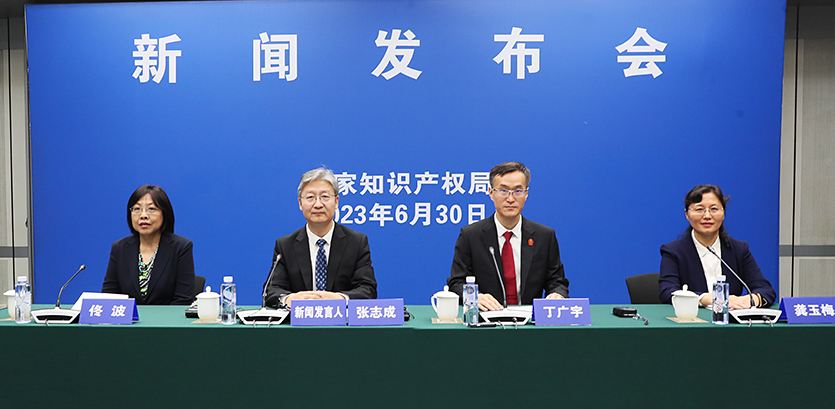
On June 30, the State Intellectual Property Office held a regular press conference in June, released the white paper "The Status of Intellectual Property Protection in China in 2022", and answered reporters' questions on relevant issues.
Picture and text records
Spokesperson of the State Intellectual Property Office and Director of the Intellectual Property Protection Department Zhang Zhicheng
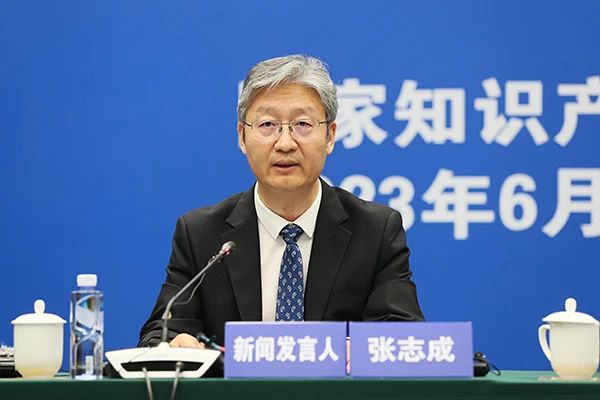
Dear friends from the media, good morning! Welcome to the June regular press conference of the State Intellectual Property Office, and thank you all for your long-term concern and support for intellectual property work. Today, we will release the white paper "The Status of Intellectual Property Protection in China in 2022" and answer your questions. Attending today's press conference were: Ding Guangyu, Vice President of the Third Civil Trial Division of the Supreme People's Court, Tong Bo, Deputy Director of the Law Enforcement and Inspection Bureau of the State Administration for Market Regulation, and Gong Yumei, Deputy Director of the Science and Technology Development Center of the State Forestry and Grassland Administration. I am Zhang Zhicheng, spokesperson and director of the Intellectual Property Protection Department of the State Intellectual Property Office.
General Secretary Xi Jinping emphasized that innovation is the first driving force for development, and protecting intellectual property rights is protecting innovation. To comprehensively build a modern socialist country, we must better promote intellectual property protection. All regions and departments conscientiously implement the spirit of General Secretary Xi Jinping’s important instructions and comprehensively strengthen intellectual property protection. In order to showcase the progress and results in related fields, the State Intellectual Property Office, together with relevant departments, has published white papers on the status of intellectual property protection in China for many consecutive years, which has attracted widespread attention from domestic and foreign media and the public. Below, I briefly introduce the main contents of the 2022 white paper.
In 2022, the Chinese government will further consolidate the foundation of the rule of law for intellectual property rights, deepen the reform of the intellectual property protection system and mechanisms, continuously strengthen the protection of the entire chain of intellectual property rights, build a strong security barrier in the field of intellectual property rights, carry out extensive publicity and training on intellectual property protection, and make positive progress in various tasks. . Social satisfaction with intellectual property protection has further improved, with the satisfaction score reaching 81.25 points, and the overall situation has entered a good stage. The white paper introduces the progress of China's intellectual property protection in 2022 from five aspects, and attaches multiple columns to focus on typical cases in intellectual property protection.
First, in terms of protection effectiveness, the protection of the whole chain has been continuously strengthened, and the results of all aspects of work have been remarkable. In 2022, the Chinese government will continue to make efforts in strict protection, large-scale protection, rapid protection, and simultaneous protection of intellectual property rights. Continuously strengthen the civil, administrative and criminal trials of intellectual property rights, and do in-depth and practical work related to intellectual property prosecution; organize and carry out multiple special administrative law enforcement actions to strengthen patents, trademarks, copyrights, Olympic symbols, new plant varieties, anti-unfair competition, etc. Intellectual property protection in key areas and key links such as customs and online markets; continue to strengthen protection capacity building, improve intellectual property protection work systems and mechanisms, strengthen inspection, assessment and evaluation of protection work, strengthen enforcement guidance for trademarks, patents, etc., and improve rapid coordinated protection , rights protection assistance, dispute mediation and other working mechanisms, intensify the crackdown on irregular patent applications and malicious trademark registrations, carry out national innovative pilot projects for trade secret protection, and strengthen the construction of overseas intellectual property dispute response mechanisms.
Second, in terms of institutional construction, the institutional system has been continuously improved, and positive progress has been made in the construction of the rule of law. In 2022, we will adhere to the requirements of comprehensively governing the country according to law and strive to strengthen the legal protection of intellectual property rights. Throughout the year, 3 laws and regulations related to intellectual property were revised and implemented, 2 judicial interpretations related to intellectual property protection were issued, and more than 20 normative documents and policy documents related to the implementation of intellectual property protection were issued. Local comprehensive legislation on intellectual property protection has made positive progress. progress.
Third, in terms of approval and registration, the number of intellectual property approval and registrations has continued to grow, and the quality and efficiency of examinations have steadily improved. As of the end of 2022, the number of valid invention patents in China was 4.212 million, a year-on-year increase of 17.1%, the number of valid utility model patents was 10.835 million, a year-on-year increase of 17.2%, and the number of valid design patents was 2.832 million, a year-on-year increase of 9.7%; China The number of valid registered trademarks is 42.672 million, a year-on-year increase of 14.6%; the total annual registration of copyrights in China is 6.353 million, a year-on-year increase of 1.4%; a total of 2,495 geographical indication products have been approved for protection, and a total of geographical indications have been approved for registration as collective trademarks and certification marks. 7,076 applications, with a total of 23,500 market entities approved for the use of special signs for geographical indications; 11,000 applications for new agricultural plant variety rights were accepted throughout the year, a year-on-year increase of 15.2%, and 3,375 applications were authorized; a total of 8,836 applications for new forest and grass plant variety rights were accepted. 4055 items were authorized.
Fourth, in terms of cultural construction, publicity channels have been effectively expanded to help the whole society further enhance the awareness of intellectual property protection. Tell the story of China’s intellectual property rights from multiple angles and show the image of a civilized and responsible country. Held a special press conference on "Intellectual Property Rights in These Ten Years" to systematically sort out the development achievements of the intellectual property cause, with nearly 4,000 related reports; published 10 white papers and series of reports on intellectual property protection, and published typical cases of intellectual property protection; successfully held national Intellectual Property Publicity Week and other important activities; continue to promote intellectual property education and training, and strengthen the development of distance courses on intellectual property.
Fifth, in terms of international cooperation, multilateral and bilateral cooperation has become deeper and more substantial, and international cooperation has achieved fruitful results. In 2022, the Chinese government will continue to deepen exchanges and cooperation with international organizations such as the World Intellectual Property Organization and intellectual property institutions in various countries and regions, deeply participate in global intellectual property governance, and advocate jointly strengthening intellectual property protection. The Hague Agreement on the International Registration of Industrial Designs and the Marrakesh Treaty on Facilitating Access to Published Works for Blind, Visually Impaired or Other Print Disabled Persons have officially entered into force in China. Implement high-quality intellectual property-related content in the Regional Comprehensive Economic Partnership Agreement. Earnestly implement the China-EU Agreement on the Protection and Cooperation of Geographical Indications and announce the second batch of China-EU geographical indication mutual recognition and mutual protection product lists.
The above is the main content of the white paper. Today we brought the white paper to the site, and the electronic version will be publicly released on the government website of the State Intellectual Property Office after the press conference. Below, we would like to answer your questions on the relevant content. Please inform your news organization before asking a question.
CCTV reporter, China Central Radio and Television Station
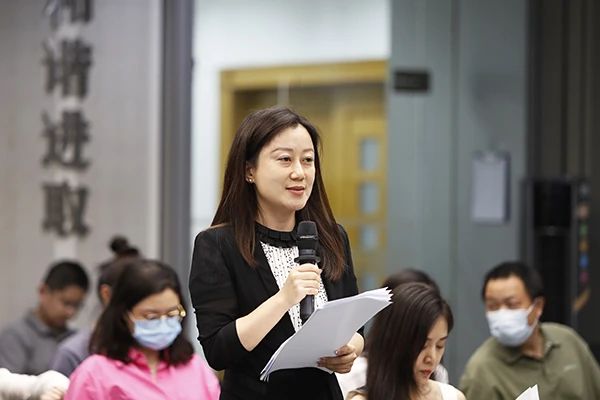
The spokesperson just mentioned that my country's intellectual property protection situation is constantly improving. The score of the social satisfaction survey on intellectual property protection has increased from 80.61 points in 2021 to 81.25 points in 2022. The overall situation has entered a good stage. Can you introduce the specific situation?
Zhang Zhicheng
Thank you for your question. It's up to me to answer this question. The most fundamental goal of doing a good job in intellectual property protection is social recognition and public satisfaction. In order to accurately understand the evaluation of all walks of life on intellectual property protection, the State Intellectual Property Office has organized and conducted social satisfaction surveys on intellectual property protection for 11 consecutive years since 2012. The survey was carried out in 31 provinces (autonomous regions and municipalities) across the country in a random sampling manner. It established 5 first-level indicators including legal policies, law enforcement protection, mechanism construction, awareness cultivation, and protection effects, and 11 second-level indicators and 31 A third-level indicator. The survey results effectively reflect the achievements of intellectual property protection work in various localities and departments.
The survey shows that in 2022, social satisfaction with intellectual property protection nationwide will increase to 81.25 points (percentage system), an increase of 0.64 points from 2021, an increase of 8.87 points from the early stage of the "Thirteenth Five-Year Plan" (2016), and an increase from the beginning of the survey. 17.56 points. Social satisfaction with intellectual property protection has continued to increase steadily over the years, which fully demonstrates that my country's intellectual property protection work has been widely recognized by all sectors of society. Looking at specific indicators: Among the five first-level indicators, the respondent group rated the completeness of the intellectual property legal policy system the highest, with a score of 82.46 points, reflecting the increasing perfection of my country's intellectual property protection system. From the perspective of the respondent groups: the satisfaction scores of intellectual property-related rights holders, the public and professionals have all improved compared with 2021. Among them, the satisfaction scores of rights holders have increased the most, increasing by 0.83 points.
Compared with the early stage of the "Thirteenth Five-Year Plan", all three types of respondent groups have improved by more than 6 points. Among them, the public's satisfaction has increased the most, with an increase of 14.62 points, indicating that more and more intellectual property protection work has been carried out. Public recognition. Judging from the types of enterprises surveyed: joint ventures had the highest satisfaction score, reaching 84.46 points. The satisfaction score of private enterprises has the largest improvement, increasing by 2.16 points compared with 2021. Compared with the early stage of the "Thirteenth Five-Year Plan", the satisfaction scores of all types of enterprises have increased significantly, which shows that intellectual property protection is playing a positive role in creating a good business environment and expanding high-level opening up to the outside world. From the perspective of regional distribution: the eastern region has the highest satisfaction score, which is 81.70 points. Compared with 2021, the satisfaction score in the central region has improved the most, increasing by 1.39 points. The overall improvement in the level of intellectual property protection has also become more obvious. In the future, the State Intellectual Property Office will continue to thoroughly study and implement Xi Jinping Thought on Socialism with Chinese Characteristics for a New Era and the spirit of the 20th National Congress of the Communist Party of China, conscientiously implement the decisions and arrangements of the Party Central Committee and the State Council, insist on taking people's satisfaction as an important criterion for measuring work, and use We will use the survey tool of social satisfaction with intellectual property protection and do our best to protect intellectual property rights. Thanks.
Reporter at Rule of Law Network
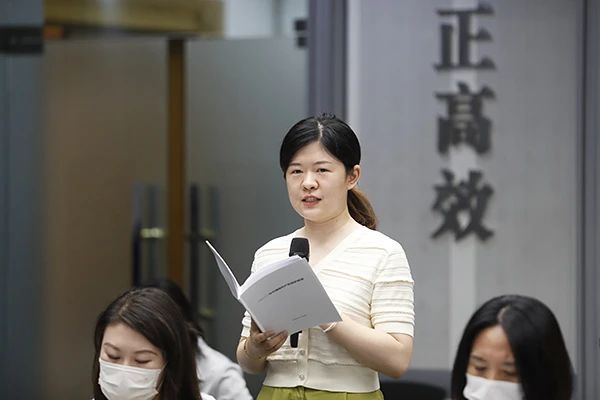
High-quality development is the primary task of building a modern socialist country in an all-round way. I would like to ask, what work has the People's Court carried out in terms of intellectual property protection around promoting high-quality development?
Ding Guangyu, Vice President of the Third Civil Trial Division of the Supreme People's Court
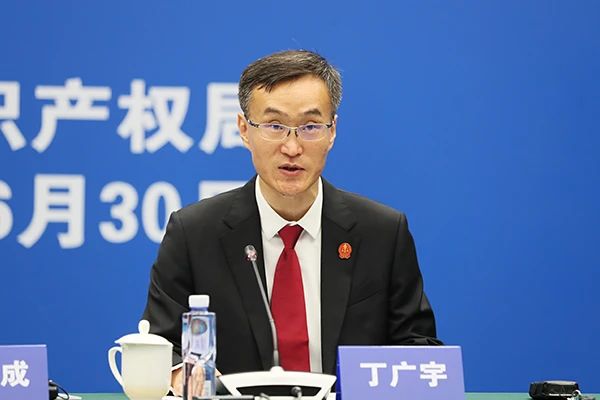
Thank you for your question. General Secretary Xi Jinping pointed out in the report of the 20th National Congress of the Communist Party of China that high-quality development is the primary task of comprehensively building a modern socialist country. In the new stage of development, innovation is the first driving force for high-quality development. The People's Court has thoroughly studied and implemented the spirit of General Secretary Xi Jinping's series of important instructions on strengthening intellectual property protection, firmly established the concept that protecting intellectual property is to protect innovation, comprehensively, strictly and collaboratively protected intellectual property, and strived to create an open environment for high-quality development driven by innovation. , a fair, just and non-discriminatory legal environment.
First, comprehensively strengthen patent technology trials to encourage and ensure technological independence and self-reliance. Last year, the People's Court received 526,165 new intellectual property cases of various types, among which the number of patent cases and technology contract disputes continued to rise. Patent civil first-instance cases increased by 23.25% year-on-year, and technology contract first-instance cases increased by 5.55% year-on-year. The role of high-quality development of intellectual property judicial services has been further highlighted. The People's Court comprehensively safeguards the legal rights of patentees and inventors in accordance with the law, strictly protects corporate trade secrets, vigorously promotes innovation in key areas, core technologies, and emerging industries, and serves to ensure new economic and new momentum. For example, in order to promote the high-quality development of the pharmaceutical industry and continuously meet the health needs of the people, the drug patent linkage system was implemented and 35 drug patent linkage lawsuits were heard, involving key drugs for the treatment of osteoporosis, leukemia, etc. For example, in two cases related to the infringement of "melamine" patents and technical secrets, the defendants were ordered to jointly and severally compensate the rights holders for a total of 218 million yuan in economic losses, which truly reflects the judicial orientation of vigorously protecting technological innovation.
The second is to accurately apply evidence rules that are consistent with the rules of intellectual property litigation to facilitate rights holders in safeguarding their rights. Focus on improving the efficiency of evidence preservation review and fix infringement evidence in a timely and effective manner. Reasonably allocate the burden of proof for intellectual property infringement, and make it clear that if a party who is required by the people's court to submit relevant evidence in accordance with the law refuses to submit it without justifiable reasons, it can be presumed that the relevant claims of the right holder are established. For example, in order to strengthen the protection of innovation in the seed industry, in the "Caitiannuo No. 6" corn seed case, despite the lack of industry identification standards, the People's Court reasonably allocated the burden of proof based on the laws of corn breeding and determined the parent-child relationship between the hybrid corn variety and the parent variety. , effectively protecting new plant variety rights.
The third is to apply punitive damages in accordance with the law to effectively curb infringements. The People's Court applies judicial interpretations of punitive damages in accordance with the law, which significantly increases the cost and price of infringement, making the infringer lose more than he gains. For example, in 2022, Shanghai Pudong Court heard 25 intellectual property punitive damages cases; Jiangsu courts heard 97 intellectual property cases subject to punitive damages, a year-on-year increase of 21.25%; Shenzhen Intermediate Court applied penalties in 29 intellectual property cases Sexual compensation, the cumulative amount of compensation awarded reached 169 million yuan.
The fourth is to intensify criminal crackdowns and punish serious infringements in accordance with the law. The "Guiding Opinions on Further Strengthening Seed-Involved Criminal Trials" was issued to increase criminal penalties for seed-related crimes. Together with the Supreme People's Procuratorate, the judicial interpretation of intellectual property criminal cases has been drafted and publicly solicited opinions, highlighting the orientation of strict intellectual property protection. Adapting to new technological changes such as artificial intelligence and the Internet of Things, the people's courts accurately grasp and identify new intellectual property crimes and effectively crack down on crimes that use new technologies to infringe on intellectual property rights. For example, in cases related to counterfeit Bluetooth headsets such as Luo Mouzhou and Ma Mouhua, the People's Court has determined in accordance with the law the new criminal act of displaying and counterfeiting other people's trademarks on mobile digital devices such as mobile phones through information sensing and intelligent identification. Criminal sanctions were imposed.
In the next step, the People's Court will further "strengthen the legal protection of intellectual property rights and strongly support comprehensive innovation", strive to create a market-oriented, legal and international first-class business environment, and provide powerful judicial services to promote high-quality development and meet the people's needs for a better life. and protection. Thanks.
Reporter at China Market Supervision News
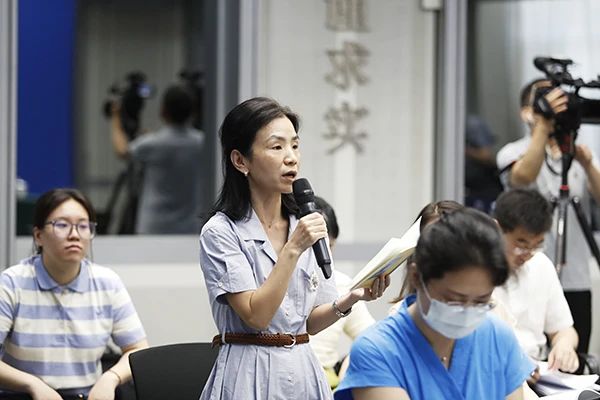
The white paper introduces the results of administrative protection of intellectual property rights in 2022. The market supervision department assumes the important responsibility of administrative enforcement of intellectual property rights. Please introduce the enforcement work in 2022 and what are your considerations for the next step in intellectual property enforcement.
Tong Bo, Deputy Director of the Law Enforcement and Inspection Bureau of the State Administration for Market Regulation
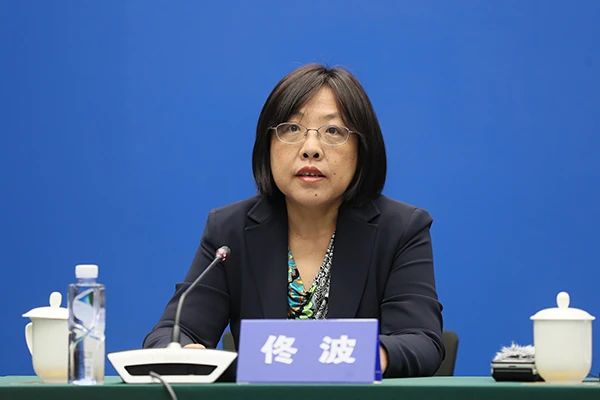
Thank you for your question. The State Administration for Market Regulation conscientiously implements the decisions and arrangements of the Party Central Committee and the State Council, gives full play to the advantages of comprehensive law enforcement in market supervision, severely cracks down on illegal activities in the fields of trademarks, patents and other fields in accordance with the law, and equally protects the intellectual property rights of all types of business entities. The first is to crack down hard on infringement and illegal activities and strive to maintain an innovative environment. In view of the prominent problems of infringement and counterfeiting that have been strongly reported by right holders and the key commodities that are related to the health and safety of the people, we will increase the efforts to identify illegal clues, coordinate and promote the investigation and handling of cases through supervision, inspection and research, performance appraisal and other means, and severely crack down on trademark infringement, Counterfeiting patents, maliciously applying for registered trademarks and other illegal activities. In 2022, market supervision departments across the country investigated a total of 43,500 illegal cases in the fields of trademarks, patents and other fields, and transferred more than 1,000 suspected criminal cases to judicial authorities, effectively protecting the legitimate rights and interests of rights holders and maintaining a good environment for innovation and development.
The second is to strengthen cross-department and cross-regional collaboration and continue to improve law enforcement effectiveness. The State Administration for Market Regulation and the State Intellectual Property Office signed a memorandum on intellectual property law enforcement and protection, establishing mechanisms for the transfer of suspected illegal clues, regular consultations, and information sharing during the review of trademark and patent applications, and strengthening the connection between daily supervision and law enforcement and case handling. Since last year, more than 60 suspected illegal clues have been sorted out, and 14 provinces (autonomous regions and municipalities) have been organized to conduct centralized investigations and punishments, creating a strong deterrent. Guide and promote the establishment of regional law enforcement cooperation mechanisms in Beijing-Tianjin-Hebei, the Yangtze River Delta, the Huaihai Economic Zone, and the Northwest Region to provide guarantees for the entire chain to crack down on illegal activities.
The third is to actively explore innovative methods of law enforcement and continuously optimize the effectiveness of case handling. Adhere to equal emphasis on law enforcement and case handling and system construction, and guide local governments to explore innovative methods of law enforcement. Based on the circumstances of different intellectual property violations, the Beijing Municipal Administration for Market Regulation has optimized the setting of case review authority, strengthened case analysis and classification guidance, and effectively shortened the case handling cycle. The Shandong Provincial Market Supervision Bureau has formulated the "Interim Provisions on the Separation of Complex and Simplified Administrative Penalty Cases in the Field of Intellectual Property Rights" to clarify corresponding procedures and case handling requirements based on the complexity of intellectual property cases, handle simple cases quickly and handle complex cases intensively, and make full use of limited law enforcement resources to achieve Better law enforcement effectiveness.
In the next step, market supervision departments will continue to further promote the enforcement of intellectual property rights. First, continue to increase law enforcement efforts. Focus on the physical market, the Internet field where infringement and counterfeiting is common, and key commodities related to the health and safety of the people, strengthen clue identification and supervision, organize the investigation and handling of a number of major and important cases, and equally protect the intellectual property rights of domestic and foreign-funded enterprises in accordance with the law. The second is to actively solve law enforcement problems. Carry out a three-year campaign to improve "digital + law enforcement" capabilities, conduct an in-depth analysis of the laws of illegal behavior in the Internet field, and further improve the full-chain law enforcement mechanism that combines online and offline, linkage between up and down, and regional collaboration. Select places with good foundations to carry out pilot projects, rely on e-commerce platform big data resources, express logistics and other information to open up production, circulation, sales and other links, and strive to eradicate illegal industrial chains. The third is to continuously improve safeguard measures. Carry out in-depth research, study and formulate work guidelines for the difficulties and blocking points in law enforcement, strengthen business guidance and hierarchical supervision of law enforcement cases, and enhance the uniformity and standardization of law enforcement. Promote classified and precise law enforcement, and make extensive use of punishment, education, warnings, interviews, etc. to ensure that the effects of law enforcement are consistent with the social effects.
China Daily reporter
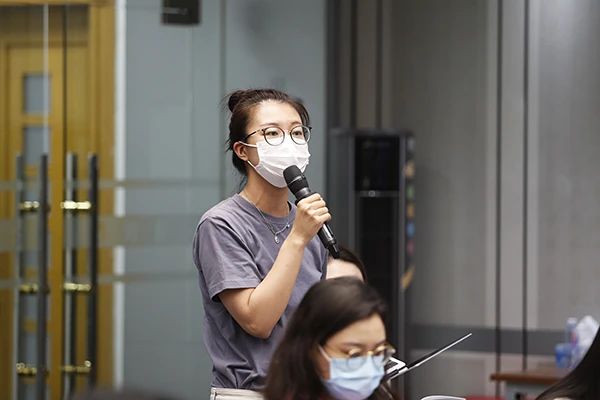
Intellectual property protection is closely related to economic and social development. The innovation of forest and grass varieties plays an important role in the development of forestry and the construction of ecological civilization. Please tell me, what is the current progress in intellectual property protection in the forestry and grass industry?
Gong Yumei, deputy director of the Science and Technology Development Center of the State Forestry and Grassland Administration
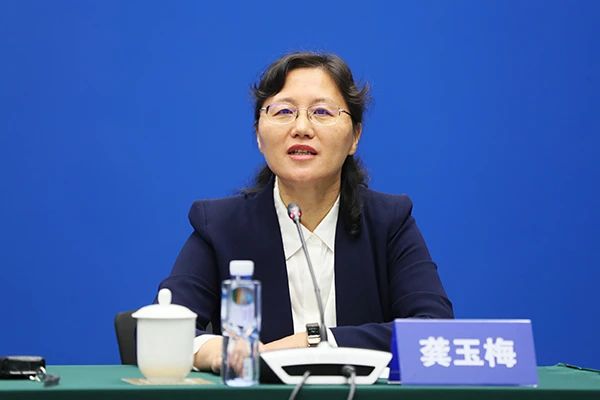
Thank you for your question. In accordance with the overall arrangements of the "Outline for Building a Strong Country on Intellectual Property (2021-2035)" and the "14th Five-Year Plan for the Protection and Application of National Intellectual Property", the State Forestry and Grassland Administration will focus on the creation of new varieties of forest and grass plants to comprehensively promote Forestry and grassland intellectual property protection work. The first is to upgrade and optimize the "Protection and Management System for New Varieties of Forest and Grass Plants" and continue to promote the efficiency and service level of new variety rights acceptance and review. In 2022, 1,828 applications for new plant variety rights were accepted, and 651 were authorized. The number of applications increased by 27% year-on-year, setting another record high. As of the end of June 2023, a total of 9,572 applications for new varieties of forest and grass plants had been accepted, and a total of 4,272 applications had been authorized.
The second is to carry out special operations to combat infringement, and continue to work hard to combat counterfeiting and protect rights. In June last year, the Office of the State Forestry and Grassland Administration issued the "Notice on Organizing and Carrying out Work to Combat the Production and Sale of Fake Forest and Grass Seedlings and Infringement of New Plant Variety Rights in 2022", organizing efforts to focus on cracking down on infringement and counterfeit new varieties of forest and grass plants. Special actions were taken to strengthen the organizational leadership of administrative law enforcement for new plant varieties and improve the authority of law enforcement. In order to further increase punitive damages and strengthen administrative law enforcement, we are currently revising the "Administrative Law Enforcement Measures for the Protection of New Varieties of Forest and Grass Plants", and a draft for comments has now been completed.
The third is to actively promote the transformation and application of forest and grassland intellectual property rights. On the one hand, we vigorously implement forest and grassland intellectual property rights transformation and utilization projects. In the 12 years from 2011 to 2022, the State Forestry and Grassland Administration organized and implemented a total of 107 forestry and grassland intellectual property conversion and application projects, many of which have very obvious effects in promoting the development of rural industries. On the other hand, we continue to promote new varieties of forest and grass plants to benefit farmers. In the past few years, intellectual property rights have played an important role in helping to alleviate poverty and promote rural revitalization through patented technologies, trademarks and brands, geographical indications, and new plant varieties. Recently, we have launched the “National Collection of Typical Cases of New Forest and Grass Plant Varieties that Benefit Farmers”, encouraging localities to conduct pilot trials and explore models for the transformation and application of new excellent plant varieties and benefiting farmers.
The fourth is to increase the publicity of forest and grassland intellectual property rights. In recent years, we have simultaneously launched the "Forest and Grassland Intellectual Property Publicity Series" during the National Intellectual Property Week, including the production of the "News 2+1" Forestry and Grassland Intellectual Property Publicity Week special program and the "Preview of New Varieties of Excellent Forest and Grass Plants" short film The video, through international platforms such as the International Union for the Protection of New Varieties of Plants (UPOV) and the World Intellectual Property Organization (WIPO), promotes China’s new varieties of excellent forest and grass plants, outstanding young forest and grass plant breeders, and the deeds of female breeders. It was published on People’s Daily Online, Xinhuanet, People’s Daily, Daily, China Green Times and other platforms carried out series of reports. Thanks.
Reporter at China Intellectual Property News
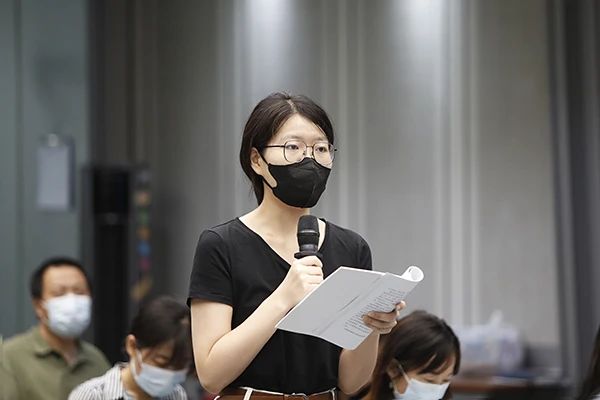
We noticed that the white paper specifically mentions the mediation of intellectual property disputes. At the same time, I also learned that the Office of the State Intellectual Property Office and the General Office of the Supreme People's Court jointly released typical experiences, practices and cases of multi-dimensional mediation of intellectual property disputes in 2021-2022. Could you please introduce the relevant situation and the results of this work.
Zhang Zhicheng
Thank you for your question. Intellectual property dispute mediation is an important measure to optimize the business environment. In recent years, the State Intellectual Property Office has thoroughly implemented the spirit of General Secretary Xi Jinping’s important instructions on strengthening intellectual property protection, continuously improved the intellectual property dispute mediation system in conjunction with the Supreme People’s Court and the Ministry of Justice, and guided local governments to carry out intellectual property dispute mediation work.
First, pay more attention to the advantages of mediation. Focus on preventing and resolving conflicts and disputes from the source, complementing administrative protection and judicial protection, and laying out "multiple lanes" for the resolution of intellectual property disputes, making rights holders' rights protection options more diverse and convenient. The white paper also mentioned that there are more than 1,700 people's mediation organizations for intellectual property disputes across the country, of which more than 1,200 are guided and managed by intellectual property departments at all levels. According to statistics, more than 20,000 mediation cases were accepted in the first quarter of 2023, of which more than 16,000 were through online mediation. The average case processing cycle is 28 days, which can resolve a large number of conflicts and disputes in a short period of time.
The second is to focus more on key service areas. Continuously meet the needs of various market entities, focusing on areas where intellectual property disputes are prone to occur, such as small, medium and micro enterprises, professional markets, e-commerce platforms, exhibitions, etc., and resolve disputes in a timely manner through mediation. As of the first quarter of 2023, 537 intellectual property dispute mediation organizations and 3,823 mediators from 29 provinces (autonomous regions and municipalities) and the Xinjiang Production and Construction Corps have been promoted to the People's Court Mediation Platform, and 8,700 mediation cases were handled through the mediation platform in the quarter. remaining items.
The third is to pay more attention to the role of typical models. As this media friend mentioned, the State Intellectual Property Office, together with the Supreme People's Court, organized for the first time the selection of typical experiences, practices and cases in multi-dimensional mediation of intellectual property disputes, and released the first batch of 10 typical experiences from 10 provinces (autonomous regions and municipalities). Practice and 10 cases. Typical experiences and cases not only demonstrate the effectiveness of dispute prevention at the source, online mediation, diversified resolution, and one-stop dispute resolution in the field of intellectual property, but are also vivid practices of intellectual property dispute mediation in optimizing the business environment and serving high-quality development. After its release, it aroused positive responses from various places.
In the next step, the State Intellectual Property Office will continue to strengthen the coordination of intellectual property dispute mediation, work with the Supreme People's Court and the Ministry of Justice to continue to promote the mediation of intellectual property disputes, and better play the important role of mediation in resolving conflicts and disputes in the field of intellectual property. Thanks.
China News Agency reporter

I am a reporter from China News Service. We have noticed that the President of the Supreme People's Court emphasized the need to tighten the management of sources of litigation and proactively integrate them into national governance and social governance. We would like to know how the People's Court strengthens the management of sources of litigation in the field of intellectual property trials. ?
Ding Guangyu
Thank you for your question. General Secretary Xi Jinping pointed out that non-litigation dispute resolution mechanisms should be put in the forefront and more legal forces should be directed towards guidance and guidance. The report of the 20th National Congress of the Communist Party of China emphasized the need to improve the social governance system of joint construction, joint governance and sharing, and improve the efficiency of social governance. Source-of-litigation governance is a specific form for the people's courts to resolve conflicts and disputes. It is a judicial response that meets the people's new judicial needs and expectations. It is an important way to participate in social governance and national governance.
In the judicial field of intellectual property rights, the People's Court: First, insist on putting non-litigation dispute mechanisms at the forefront and promote diversified resolution of intellectual property disputes. Deepen the implementation of the "head-to-head" online litigation and mediation working mechanism with the State Intellectual Property Office and other units, and provide parties with "one-stop" services such as online mediation and online judicial confirmation. Intellectual property mediation organizations are fully covered in 30 regions across the country, and the number of mediation organizations and mediators stationed in the country continues to increase. Last year, the People's Court appointed pre-litigation mediation for more than 90,000 disputes. Regarding foreign-related intellectual property disputes, the three high courts of Shanghai, Fujian and Hainan have successively cooperated with the World Intellectual Property Organization to establish arbitration and mediation mechanisms. For example, last year, the Shanghai Court entrusted the World Intellectual Property Organization with a mediation rate of more than 40% in foreign-related cases, which has achieved remarkable results in resolving disputes and promoting the transformation of intellectual property applications.
The second is to persist in substantively resolving conflicts and significantly improve the people's sense of access to justice. The People's Court attaches great importance to judicial mediation and effectively reduces the burden of litigation for the parties. In 2022, 44,155 first-instance civil intellectual property cases were settled through mediation in courts across the country, with a mediation settlement rate of 9.64%. The mediation settlement rates of Guangzhou Intellectual Property Court and Shanghai Intellectual Property Court both exceeded 20%, reaching a record high.
The third is to persist in collaborative reform and innovation to promote the continuous optimization of the overall intellectual property protection work pattern. We cooperate with the State Intellectual Property Office to explore the synchronization of patent administrative confirmation and court infringement dispute trials, effectively shortening the trial cycle of patent infringement cases and improving protection effects. In November last year, the Supreme People's Court, the State Intellectual Property Office, the Supreme People's Procuratorate and others jointly issued the "Opinions on Strengthening the Cohesion of Intellectual Property Appraisal Work" to deepen cooperation between various departments in intellectual property appraisal work. Conduct joint research and business exchanges in areas such as data property rights protection and artificial intelligence to jointly promote the improvement of legal policies.
The fourth is to insist on "grasping the front end and treating the disease before it occurs", and promote source management and comprehensive management in the field of intellectual property rights. For key areas and industries of intellectual property, the people's courts have given full play to their role in judicial advice and transformed trial results into governance results. For example, the Beijing Intellectual Property Court sent judicial suggestions to the catering delivery platform on improving the real-name authentication and review mechanism process for online users in response to the situation where individual operators may fraudulently use or misappropriate someone else's illegally obtained business license when registering an online store on a catering delivery platform. Promote and standardize the order of the online takeout food industry. The Hainan Free Trade Port Intellectual Property Court issued judicial recommendations to the Provincial Market Supervision Bureau and the Provincial Intellectual Property Office to include 12 people in 9 criminal cases of intellectual property infringement on the list of serious intellectual property violations and untrustworthy subjects to promote the respect and protection of intellectual property rights in the whole society. consciousness. Jiangsu courts have issued nearly 100 "inhibition orders" for criminal violations of intellectual property rights in key areas of people's livelihood, such as food and medicine.
In the next step, the People's Court will fully implement Xi Jinping's thought on the rule of law, further strengthen the governance of litigation sources in the field of intellectual property, continue to make efforts in source diversion, substantive resolution, and comprehensive governance, promote the modernization of the intellectual property governance system and governance capabilities, and fully utilize The rule of law thinking and the rule of law protect the rights and interests of the people, and answer the questionnaire of the times that satisfies the people with fair and efficient justice. Thanks.
Reporter of "Bauhinia" magazine

The white paper mentioned that market supervision departments and other law enforcement agencies have investigated and dealt with a large number of intellectual property violation cases, and the handling of the items involved is an issue of great concern to rights holders. I would like to ask Deputy Director Tong Bo to introduce how the seized infringing and counterfeit goods are handled?
Tong Bo
Thank you for your question. How to deal with the infringing and counterfeit goods involved in the case is an issue of common concern to the rights holders and the public. In accordance with laws and regulations related to intellectual property, infringing and counterfeit goods seized by law enforcement agencies during supervision and enforcement must be destroyed in accordance with the law. This is an important measure to prevent infringing and counterfeit goods from re-entering circulation channels, effectively protecting the interests of rights holders and safeguarding the lives, health and safety of the people. It is also a powerful means to purify the market environment and form a strong deterrent to lawbreakers. In recent years, the State Administration for Market Regulation has vigorously promoted the destruction of infringing and counterfeit goods from the aspects of system construction and practical actions.
The first is to improve relevant institutional regulations. In August 2020, the State Administration for Market Regulation, together with the Central Propaganda Department, the Supreme People's Court, the Supreme People's Procuratorate, the Ministry of Public Security, the Ministry of Ecology and Environment, the Ministry of Culture and Tourism, the General Administration of Customs, etc., jointly issued the "Opinions on Strengthening the Destruction of Infringing and Counterfeit Goods" 》, which makes detailed provisions on the scope, time limit, procedures, supervision, and assessment of destruction, and strives to solve the problems of non-environmental destruction, non-standard procedures, random placement of items, and long stagnation time, etc., and provides a guide for all localities to do a good job in destruction work. Institutional guarantee.
The second is to organize unified destruction operations. For three consecutive years, the State Administration for Market Regulation has organized nationwide unified destruction of infringing and counterfeit goods to fundamentally eliminate the recirculation of infringing and counterfeit goods. On November 10, 2022, 18 provinces (autonomous regions and municipalities) across the country were organized to simultaneously destroy more than 30 categories and more than 100 varieties of infringing and counterfeit goods, with a value of 500 million yuan. According to statistics, since 2020, local market supervision departments have destroyed infringing and counterfeit goods more than 2,000 times, destroying more than 12 million tons of infringing and counterfeit goods. In September this year, the State Administration for Market Regulation will continue to organize a nationwide unified destruction of infringing and counterfeit goods. Media friends are also invited to pay attention to it.
In the next step, the State Administration for Market Regulation will rely on the coordination and promotion working mechanism to build a quality powerhouse, continue to coordinate and strengthen the fight against infringement and counterfeiting, improve the cross-department and cross-level intellectual property law enforcement collaborative work system, and further do a good job in the destruction of infringing and counterfeit goods to provide high-quality products. Develop and create a good market environment. Thanks.
Zhejiang Daily Chao News Reporter
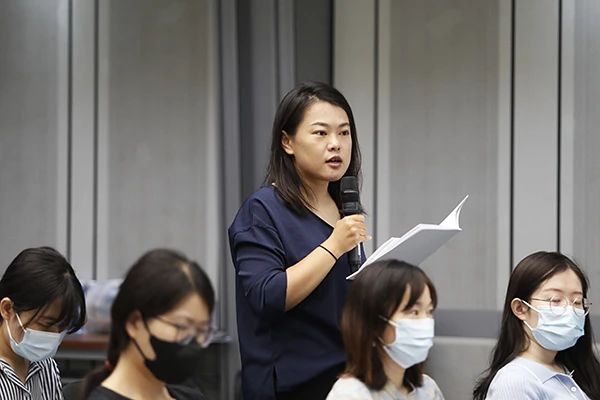
“Clear waters and lush mountains are mountains of gold and silver.” In conjunction with rural revitalization, can you introduce the results of your work on forestry and grassland intellectual property rights and protection of new plant varieties?
Gong Yumei
Thank you for your question. The report of the 20th National Congress of the Communist Party of China pointed out that "establish a comprehensive food concept and build a diversified food supply system." General Secretary Xi Jinping emphasized at the Central Rural Work Conference that industrial revitalization is the top priority for rural revitalization. It is necessary to do a good job in "local specialties" and rely on agricultural and rural characteristic resources to benefit from developing multiple agricultural functions and tapping rural diverse values. , seeking benefits from the integrated development of primary, secondary and tertiary industries. This year’s government work report lists “developing rural characteristic industries and broadening channels for farmers to increase income and become rich” as a key task for rural revitalization.
For forestry and grassland intellectual property rights, it is most closely integrated with rural industries. We have been thinking about how new varieties of forest and grass plants can play a greater role in "building a diversified food supply system", "developing rural characteristic industries, broadening channels for farmers to increase income and becoming rich", and giving high-quality play to the "four reservoirs" functions of forests. The transformation and application of intellectual property rights is an important way for scientific and technological achievements to strengthen and enrich agriculture, promote agriculture and benefit farmers. What we are talking about about patented technologies to strengthen agriculture and new plant varieties to benefit farmers is to use policies, funds, markets and other means to promote the transformation and application of forest and grass patents and new plant varieties so that more of the benefits can flow to our farmers. Benefits include ecological benefits and economic benefits, etc. Therefore, we use the system as a starting point to combine regional characteristic resources to help develop rural characteristic industries, increase farmers’ income channels, and realize patented technologies and new plant varieties to benefit farmers.
When we summarized the forest and grassland intellectual property rights conversion and application projects, we found that many forestry and grassland patented technologies have very outstanding effects in strengthening agriculture and benefiting farmers. For example, the patented black fungus hanging bag cultivation technology implemented in Libo, Guizhou has greatly improved land utilization and cultivation efficiency, and has effectively solved the problems of ear rot and inability to pick on rainy days. The cultivation of black fungus sticks per unit area of land has The quantity is 5-6 times that of the ground pendulum model. Each black fungus greenhouse achieves a total output of more than 1,000 kilograms and a total output value of more than 100,000 yuan. At the same time, new forest and grass varieties are gradually exploring implementation paths in "establishing a big food concept and building a diversified food supply system". Some make full use of underforest resources to open up new industrial fields; some use special economic trees to make The farmers bulged their wallets. For example, Aiyukou Village in Kuancheng County, Hebei Province has promoted the rapid development of the chestnut industry by planting new chestnut varieties and established the "No. 1 chestnut village in Jingdong". It has achieved an annual per capita income increase of more than 1,000 yuan and a total annual income increase of more than 2 million yuan, truly reaching the new level. The goal of varieties is to benefit farmers. Thanks.
Zhang Zhicheng
Due to time constraints, the media’s questions will end here. Thank you to all the guests who attended the press conference and to all friends from the media. Regarding intellectual property work, if you have any other questions of concern, you are welcome to contact our staff. This press conference ends here.
More intellectual property information and services
Follow the official subscription account of [Shenxin Intellectual Property] on the code

Follow the official service account of [Shentrust Intellectual Property Service Platform] on the code

相关新闻
Telephone:
Telephone:+86-755-82566227、82566717、13751089600
Head Office:13 / F, Building 14, Longhua Science and Technology Innovation Center (Mission Hills), No. 8 Golf Avenue, Guanlan Street, Longhua District, Shenzhen
Head Office:
13 / F, Building 14, Longhua Science and Technology Innovation Center (Mission Hills), No. 8 Golf Avenue, Guanlan Street, Longhua District, Shenzhen
Subsidiary Company:2808, Block B2, Yuexiu Xinghui Junbo, No.18 Tazihu East Road, Jiangan District, Wuhan City, Hubei Province
Subsidiary Company:
2808, Block B2, Yuexiu Xinghui Junbo, No.18 Tazihu East Road, Jiangan District, Wuhan City, Hubei Province

Service Number

Subscription Number
Copyright ©2016 Shenzhen Shenkexin patent Agency Co., LTD All rights reserved | 粤ICP备2021174526号
Copyright ©2016 深圳市深可信专利代理有限公司 版权所有 | 粤ICP备2021174526号 SEO标签
Copyright ©2016 深圳市深可信专利代理有限公司 版权所有